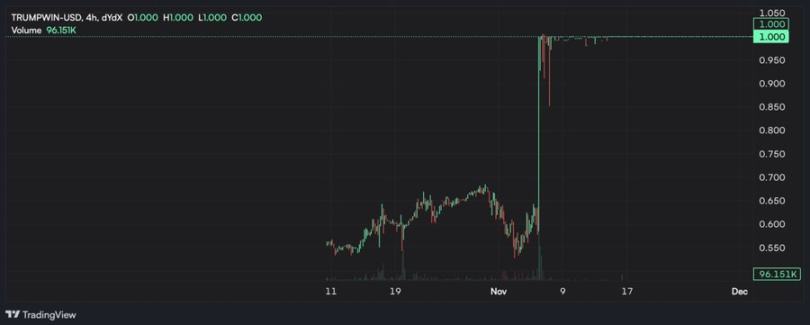Author: John Wang
Translation: AididiaoJP, Foresight News
Abstract
- HIP-3 can transform prediction markets from static betting to high-leverage perpetual contracts, enabling permissionless trading on events such as elections and macroeconomic data.
- Binary markets face extreme gap risks at expiration, making structural safeguards essential. For example: liquidation ranges, margin adjustments based on open contracts, and leverage decay.
- Scalar markets (settled by range) are a safer near-term goal due to their smoother price paths, proportional loss calculations, and lower synchronization of liquidations, thus supporting higher leverage.
- With thoughtful design, HIP-3 can serve as a complement and alternative to Kalshi and Polymarket, combining leverage, shared liquidity, permissionless market creation, and potential on-chain hedging functions to create the fastest and most flexible prediction market trading platform.
Introduction and Opportunities
Prediction markets have long been slow, fixed-payout, and non-leveraged trading venues. HIP-3 achieves permissionless deployment, shared liquidity, and customizable parameters by operating on Hyperliquid's perpetual contracts. This allows users to trade binary or continuous outcomes on events such as elections, macro data, and sports with the same speed and capital efficiency as cryptocurrency perpetual contracts.
Combining the global liquidity of perpetual contracts with the information richness of prediction markets will open up a new category of high-frequency, multi-event trading. However, without structural safeguards, leveraged trading in event markets can be very risky, especially for binary outcomes.
Challenges of Binary Leverage
Binary markets can gap from 0 to 100 at expiration, instantly destroying one side of the bettors and triggering a chain liquidation across the market. Without natural hedging, market makers will bear the event risk directly, and liquidation cannot occur in phases. In the absence of protective measures, the safe leverage ratio is only 1-1.5 times.
Example: dYdX's TRUMPWIN
On the eve of the 2024 U.S. presidential election, dYdX provided 20x leverage for the Trump victory market by allowing market makers to hedge in Polymarket's liquidity YES/NO contracts, supported by a mature liquidation mechanism, a large insurance fund, and socialized losses. Even so, on election night, the market price surged from about $0.60 to $1, leading to liquidity depletion during the liquidation process and triggering random deleveraging in an insufficiently deep order book. Delayed hedging, extreme gaps, and the disappearance of liquidity caused traders who could have fulfilled their trades to incur losses.

Currently, HIP-3 defaults to lacking on-chain hedging and gap risk control measures, so without built-in protections, similar chain reactions may still occur.
Construction Based on External Oracles
The binary prediction perpetual contracts on HIP-3 will use BinaryHyperp contracts and rely on a probability oracle ranging from 0 to 100. By strictly limiting, it ensures that trading occurs only within market boundaries. If the oracle references Kalshi or Polymarket, liquidity providers can hedge in these spot markets, thereby reducing event risk and allowing for higher leverage. However, risks still exist, including hedging delays, liquidity gaps, and funding basis differentiation.
Ensuring Leverage Safety
To raise the leverage ratio of binary markets above 1x, structural control measures are essential:
- Liquidation ranges: Segment positions by price range. Lower ranges are prioritized for liquidation to control losses.
- Margin coefficients based on open contracts: Linearly increase margin requirements based on open notional value: opennotional = OI × oraclepricescalingfactor = (opennotional - lowercap) / (uppercap - lowercap) effectivemargin = min(basemargin + max(scalingfactor × (1 - base_margin), 0), 1.0)
- Leverage decay: Gradually compress the maximum leverage ratio as the expiration date approaches and market volatility increases (e.g., 5x at 30 days, reducing to 1x on the last day).
- Pre-settlement auctions: Batch match positions before results are determined to avoid last-minute chaos.
- Price and oracle caps: Limit the magnitude of single price jumps and rate-limit oracle updates to slow down chain reactions.
By combining these measures, the margin cap based on open contracts can control systemic risk, liquidation ranges can stagger liquidation times, and leverage decay reduces tail risk as the expiration date approaches.
Beyond Binary: Breakthroughs in Scalar Markets
Scalar markets settle by range (e.g., CPI percentage or BTC dominance) rather than 0 or 100. This significantly reduces gap risks and supports higher leverage. Their main advantages include:
Smoother price paths: Most scalar markets settle based on gradually changing inputs (e.g., temperature, voting shares, or asset dominance).
- Proportional losses: Even in the event of a gap, losses are only on the deviation portion, not the full notional value.
- Predictable funding rates and liquidations: Continuous pricing disperses liquidation thresholds along the curve, reducing synchronized chain reactions.
Incremental pricing also naturally aligns with HIP-3's funding fees and margin logic, making scalar markets a safer breakthrough in the near term.
User Experience of Prediction Perpetual Contracts
Retaining the core elements of perpetual contracts (such as order books, depth charts, and leverage sliders) while adding components unique to prediction markets in the UI:
- Clear question titles
- Yes/No options or scalar sliders
- Payout visualization tools
- Countdown to expiration
- Mark price and oracle probability display
If the market hedges through external platforms like Kalshi or Polymarket, it should be prominently marked.
Positioning Comparison with Kalshi and Polymarket
Kalshi and Polymarket are curated, fixed-payout, and non-leveraged platforms. The differentiation of HIP-3 lies in:
- Leverage: Scalar markets are safer, and binary markets are engineered for optimization.
- Permissionless market creation: Anyone can list new outcomes.
- Shared liquidity: Access to Hyperliquid's perpetual contract liquidity pool.
- On-chain hedging potential: Reduce event risk without leaving Hyperliquid.
This combination can attract professional liquidity providers and active traders, allowing HIP-3 to serve both niche event markets and cover high-traffic global outcomes.
Conclusion
Currently, no major team is publicly committed to developing HIP-3 prediction perpetual contracts, but this situation is about to change. With thoughtful design, liquidity, and permissionless market creation, HIP-3 can both complement and serve as an alternative to Kalshi and Polymarket.
Prediction markets are set to sweep the globe, and as a blockchain that accommodates all financial activities, Hyperliquid will not miss this wave.
免责声明:本文章仅代表作者个人观点,不代表本平台的立场和观点。本文章仅供信息分享,不构成对任何人的任何投资建议。用户与作者之间的任何争议,与本平台无关。如网页中刊载的文章或图片涉及侵权,请提供相关的权利证明和身份证明发送邮件到support@aicoin.com,本平台相关工作人员将会进行核查。




